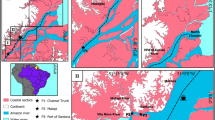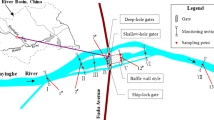Abstract
The effects of chemical spills on aquatic nontarget organisms were evaluated in this study. Based on a review of three types of current eco-toxicological models of chemicals, i.e., ACQUATOX model of the US-EPA, Hudson River Model of PCBs, and critical body residual (CBR) model and dynamic energy budget (DEBtox) model, this paper presents an uncoupled numerical ecotoxicological model. The transport and transformation of spilled chemicals were simulated by a chemical transport model (including flow and sediment transport), and the mortalities of an organism caused by the chemicals were simulated by the extended threshold damage model, separately. Due to extreme scarcity of data, this model was applied to two hypothetical cases of chemical spills happening upstream of a lake. Theoretical analysis and simulated results indicated that this model is capable of reasonably predicting the acute effects of chemical spills on aquatic ecosystems or organism killings.
Similar content being viewed by others
References
Barnes R S K, Mann K H. Fundamentals of Aquatic Ecology. 2nd ed. Boston: Blackwell Scientific Publications, 1991
Rand G. M. Fundamentals of Aquatic Toxicology: Effects, Environmental Fate, and Risk Assessment. 2nd ed. Washington, DC: Taylor & Francis, 1995
Roy K. Ecotoxicological modeling and risk assessment using chemometric tools. Molecular Diversity, 2006, 10: 93–94
McCarty L S, Mackay D. Enhancing ecotoxicological modeling and assessment: Body residuals and modes of toxic action. Environmental Science & Technology, 1993, 27: 1719–1728
Park R A, Clough J S. Aquatox (Release 2): Modeling Environmental Fate and Ecological Effects in Aquatic Ecosystems. Technical Documentation for Environmental Protection Agency. 2004
TAMS Consultants, Inc, Limno-Tech, Inc, Menzie-Cura & Associates, Inc, and Tetra Tech, Inc. Phase report-review copy: Further site characterization and analysis. Volume 2d-Revised baseline modeling report. Hudson River PCBs Reassessment RI/FS For U.S. Environmental Protection Agency Region 2 and U. S. Army Corps of Engineers Kansas City Distrcit. 2000
Kooijman S A L M. Parametric analysis of mortality rates in bioassays. Water Research, 1981, 15(1): 107–119
Legierse K C H M, Verhaar H J M, Vaes W H J, De Bruijn J H M, Hermens J L M. Analysis of the time-dependent acute aquatic toxicity of organophosphorus pesticides: The critical target occupation model. Environmental Science & Technology, 1999, 33(6): 917–925
Lee J H, Landrum P F, Koh C H. Prediction of time-dependent PAH toxicity in Hyalella azteca using a damage assessment model. Environmental Science & Technology, 2002, 36(14): 3131–3138
Kooijman S A L M. Dynamic Energy Budgets in Biological Systems: Theory and Applications in Ecotoxicology. Cambridge: Cambridge University Press, 1993
Jager T, Kooijman S A L M. Modeling receptor kinetics in the analysis of survival data for organophosphorus pesticides. Environmental Science & Technology, 2005, 39(21): 8307–8314
Ashauer R, Boxall A B A, Drown C D. New ecotoxicological model to simulate survival of aquatic invertebrates after exposure to fluctuating and sequential pulses of pesticides. Environmental Science & Technology, 2007, 41(4): 1480–1486
Lee J H, Landrum P F, Hwankoh C. Toxicokinetics and time-dependent PAH toxicity in the amphipod hyalella azteca. Environmental Science & Technology, 2002, 36(14): 3124–3130
Huang S L, Wan Z H, Smith P. Numerical simulation of heavy metal pollutant transport-transformation in fluvial rivers. Journal of Hydraulic Research, IAHR, 2007, 45(4): 451–461
Huang S L. Two-dimensional numerical modeling of chemical transport-transformation in fluvial rivers: Formulation of equations and physical interpretation, Journal of Hydroinformatics, 2009, 11(2): 106–108
Mossman D J, Schnoor J L, Stumm W. Predicting the effects of a pesticide release to the Rhine River. Journal WPCF (Water Pollution Control Federation), 1988, 60(10): 1806–1812
Author information
Authors and Affiliations
Corresponding author
Rights and permissions
About this article
Cite this article
Huang, S., Jia, Y. & Wang, S.S.Y. Two-dimensional numerical and eco-toxicological modeling of chemical spills. Front. Environ. Sci. Eng. China 3, 178–185 (2009). https://doi.org/10.1007/s11783-009-0020-9
Received:
Accepted:
Published:
Issue Date:
DOI: https://doi.org/10.1007/s11783-009-0020-9




